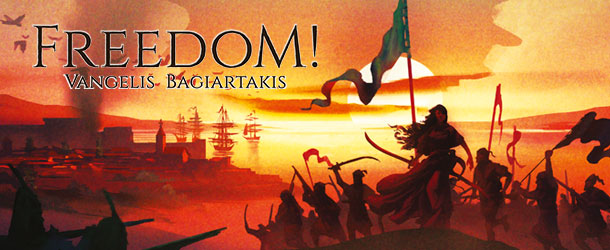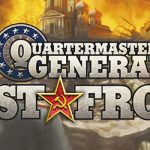The story behind the siege game Freedom!, by the game designer Vangelis Bagiartakis, continues. Following the first part detailing the inspiration, the definition of the kind of game, and the history to be included in it, here he talks about the second step: to put things down and start designing how the game would play.
Game Boards
One of the first things we realized was that the siege was not only affected by the battles that happened on the city's wall and the islets in the lagoon, but by events in the surrounding area as well. Both sides received a lot of support from nearby towns they controlled during the siege, whether in the form of supplies, new troops, or even equipment like cannons. This meant they somehow had to be incorporated into the game.
After deciding on the exact surrounding area that made sense to have in the game (and the key-locations in it) we faced another problem: in the last 200 years, some of the topology had changed (especially in regard to the lagoon). Most of the maps we could find (of that scale) were present-day maps that were not very useful. Luckily, Alexandros found a military map which showed exactly the area we wanted, during the appropriate period.
I started thinking of mechanics that would help convey the support they were providing. Initially I considered a small track beneath each location with a marker (a cube) in the middle that players would try to move towards their side in order to get a benefit. In the end, to make it less fiddly and more straightforward, Ι went with double-sided cardboard tokens. One side was for the Rebellion, the other for the Empire. Depending on who had control of the location, the markers would be stacked there with the appropriate side showing. If the opponent wanted to add Support, he would remove those tokens and when there were none left, he would add new ones, with his side up.
The last addition was the location itself become a double-sided tile. Each side corresponded to one of the two players and indicated what the location provided if you had its control, e.g. the Greek player would get new soldiers, while the Ottoman player would get supplies. The tile was also considered a marker regarding support, so even when there were no other markers on it, its side would indicate who controlled the location.

A historical map of the city showed the Ottomans' deployment positions, resembling concentric circles.
The most difficult part was of course the main map - the one depicting the city. We went over various historical maps to see the best way to depict the city until we found one that we really liked. Then, we had to figure out what spaces we should put on it and how.
That map also showed the deployment positions of the Ottomans and I realized they resembled concentric circles. I started "playing" in Inkscape, overlaying circles over those positions and in fact, they were very close. I then split the distance in four or five sections and made five concentric circles. I cut each ring in more parts and I had my spaces!
When it came to the Wall and its sections, I kept the concentric circle approach but divided the spaces according to the forts there, as they really were. Ι also added moat sections in front of each space, since it played an important role during the siege.
The lagoon and the islets in it were a bit trickier due to their distance from the city - some of them were not very near. They had played a very important role though and they also had to be somehow included. In the end, I "cheated" a bit, placing them closer than they really were (in later prototypes I would try to show that through the lines connecting them.)
The final result was this:
Yes. I know it looked like an auditorium (that's what 99% of the people who saw it said). But it didn't matter. It fit our needs and we could start playtesting!
Mechanics
Since what we wanted to make was a card-driven war game, the main mechanism was the cards and the action points they provided. Thankfully, Alexandros had read every single book he could find on the siege and had plenty of material to provide me with. However, we still had to see how exactly the action points would be spent.
The first three ways to do that was easy. One would be to move your units, another was to attack with them, and the third was to add support tokens to a surrounding area.
Beyond those three, we put other ones that made sense like building cannons, filling the moat (or emptying depending on the side), getting more units, etc. These actions, and the way they would work, allowed us to make each side feel and play differently. The rebel fighters for example would be able to move wherever they wanted inside the city. The Imperial troops however would move to adjacent spaces towards the Wall. Similarly, the rebellion could train civilians and turn them into soldiers. The Empire on the other hand depended on the units they already had (which were way more though) and the reinforcements they would get each round.
When it came to combat, I divided it into two different types: Close combat and Cannons. In the actual siege, it was extremely difficult for the outside forces to get over the Wall. Thus, I made it so that they had a 1-in-8 chance of succeeding. The besieged on the other hand, had a vantage point, firing from above, so I gave them better chances. However, there was a big difference. For every rebel fighter, there were more than 10 enemies on the other side - this had to be shown somehow. In the end I went with this: the Empire would roll two dice (8-sided) and would only hit if an 8 was rolled; the Rebellion on the other hand would roll just one die, but would hit with a result of 6 or higher. It felt right and during the first playtests it gave the players the feeling I wanted, so it was kept up to the end.
One more adjustment that we made though was this: the Imperial army consisted of mercenaries who were paid to fight. The rebels on the other side were fighting for their lives, showing more rigor and determination. To show this, I made it so that each Ottoman unit could only Attack once per turn, while a Greek unit could fire multiple times if needed. On the other hand, the Ottoman player could (as an action) spend money to encourage their units to attack, giving them a bonus in battle.
For the cannons, I didn't want to make it so that everything depended on them. If they were too powerful, then the players would just focus on firing with the cannons and there would be no close combat. On the other hand, they were an important part of the siege, so they had to be there and play a significant part. To combine all these, I made it so that the cannons had their own separate phase where they would fire, at the end of each round. This allowed them to affect the battlefield significantly, while not making them overpowered. Instead of having them use 8-sided dice, I used regular six-sided ones for them and I made it so that the farther you were away from the Wall, the harder it would be to hit (and the other way around).
One interesting historic fact that I wanted to incorporate right from the start, had to do with each side's request for assistance. By the time of the siege, there was an established Greek government in the city of Nafplio. The people in Messolonghi kept asking them for help but they were mostly ignored. However, as the siege kept on and on, and they continued to ask, the government at some point gave in and decided to send some help. That felt like it could make an interesting mechanic, so I made a small deck of cards. It was mostly "NO" cards and just a single "YES". Whenever the Greek player would ask for help, he would draw a card at random. If it was a YES, he would get a small (but crucial) amount of help - new units, supplies, morale etc. If it was a NO, the card would be removed from the deck and a YES would be put in its place, increasing the chances to get a positive answer next time.
I happen to like symmetry in games (even in asymmetrical games!!) so I was interested in finding something similar for the Empire. The answer was simple: Kutahis, who led the Imperial forces, had a lot of support from the High Porte because the Sultan wanted the city no matter what. So, initially, whatever he asked, he would get it. As the siege went on and on though, the Sultan was getting more and more impatient and wanted results - not more expenses. This fact allowed me to put the same mechanism in there for their side, but in reverse. They had a similar deck, full of YES cards and only a single NO. As the game would progress, they would lose the YES cards and have them replaced with NOs, making a NEGATIVE result more likely.
Another thing we did was divide the playing time in 12 rounds, one for each month. Each round, a specific Event would trigger (based on actual events that happened that month) and would affect the board accordingly.
Finally, there was also the matter of food. Since the day I first thought about making a game out of Messolonghi, I had this mechanism in my mind: Every round the Greek player would have to spend Food for the citizens inside the city. If no Food was available, the player would lose Morale and if the Morale ever went to 0, the game would be over. This made sense, so it was put into the game and stayed there up to the final version. As far as the other side was concerned, they also had similar problems. Since they were mercenaries, they had to be paid each round. After a point though the money would end and then, if soldiers were left unpaid, they would just leave, abandoning the siege. That in turn would cause the besiegers' morale to drop and if that reached zero then the Empire would also lose.
In the next part we'll see how the actual playtesting affected all this!
















